Marc Weidenbaum's Blog, page 64
April 23, 2024
Es Devlin’s Model Forest

A highlight from the Es Devlin exhibit at the Cooper Hewitt Museum in Manhattan. This is a plan for her installation at the 2021 Art Basel in Miami Beach, Florida. Titled Five Echoes, it was a full-scale maze based on the floor of the Chartres Cathedral, a “sound sculpture” that contained a “temporary forest”: “We immersed visitors within a soundscape that Invited them to learn each plant and tree species’ name, making a habitat for the non-human species within the human imagination.” The exhibit runs through August 11.
April 22, 2024
White Van, Whiteboard
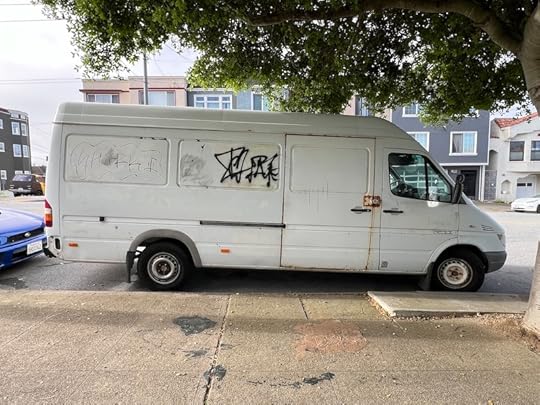
This old white van is something of a neighborhood white board. It gets written over, and then it’s painted over, and then the circle of urban life begins anew.
April 21, 2024
Pre-Show (Bill Frisell & Co.)
As I type this, I’m preparing to drive over to Berkeley, from San Francisco, to see guitarist Bill Frisell in a sextet that will be premiering new music. The group, who will play at Freight & Salvage, consists of Frisell plus violinist Jenny Scheinman, violist Eyvind Kang, cellist Hank Roberts, bassist Thomas Morgan, and drummer Rudy Royston.
There is, as far as I can tell, no available footage or audio of them playing as a group, so I’ve been piecing together a mental sonic image, as it were, from various smaller group settings.
These two short videos are all the strings from the sextet excepting the bass, filmed back on November 4, 2017. It’s the same group (Frisell, Sheinman, Kang, Roberts) who recorded the 2011 album Sign of Life (Savoy) and the 2005 album Richter 858 (Songlines). The latter was recorded back in 2002, so this is no new partnership by any means.
Roberts has, I believe, with Frisell, the longest-running association of all the musicians playing in the premiere. There’s plenty of examples, both commercial releases and live video, including this short piece, recorded June 15, 2014, at the New Directions Cello Festival, at Ithaca College, in Ithaca, New York.
Roberts was one of the first musicians I interviewed professionally, shortly after I got out of college in 1988. By then I had interviewed numerous musicians for a school publication, including the drummer Bill Bruford (Yes, King Crimson) and the Joseph Shabalala (founder of the vocal group Ladysmith Black Mambazo). After school I moved to New York City (first Manhattan and then Brooklyn), and for a solid swath of that time I was lucky to score a shared apartment on Crosby Street just south of Houston, incredibly close to the Knitting Factory, where I went several times a week and saw Frisell, Roberts, and so many “Downtown” musicians of that era in each other’s groups. I also saw Frisell play at the Village Vanguard around that time, but mostly just went to whatever was at the Knitting Factory on a given night. When I interviewed Roberts, it was on the subject of his then fairly new record, Black Pastels. (I wrote the piece for Pulse! magazine, published by Tower Records. In 1989 I moved to California to be an editor at Pulse!)
Frisell, bassist Morgan, and drummer Royston have recorded and toured widely and frequently in recent years. Here they are on July 3, 2023, at Arts Center at Duck Creek.
I’m imagining tonight’s music will have the “chamber Americana” quality of the quartet heard above, but the presence of Royston may rev things up a little, and it may have more of a jazz quality, closer to the trio work highlighted here.
April 20, 2024
Scratch Pad: Wenders, Frisell, Manhattan
I do this manually at the end of each week: collating (and sometimes lightly editing) most of the recent little comments I’ve made on social media, which I think of as my public scratch pad. Some end up on Disquiet.com earlier, sometimes in expanded form. These days I mostly hang out on Mastodon (at post.lurk.org/@disquiet), and I’m also trying out a few others. I take weekends and evenings off social media.
▰ The sole downside to opening the living room window is the terrible music that people play in their cars
▰ I saw Brad Mehldau two weeks ago. I’m seeing Bill Frisell and Hank Roberts together in a few days. Both times as part of larger ensembles (quintet and sextet respectively). Life is pretty good.
▰ Are there any recordings of Bill Frisell and Brad Mehldau playing together other than those on the soundtrack to the Wim Wenders film Million Dollar Hotel?
▰ It’s extraordinary that a subset of the consumer electronics manufacturing class happily foresees a future in which everyone openly records every interaction, including face-to-face ones. It’s a glimpse at a potential radical realignment of what it means to speak not only in public but in private.
▰ Amazing how those AI discussion summary bots that join calls can totally diminish the small talk and casual interactions. It’s like someone purposefully set out to make video calls worse.
▰ I just noticed that April 14 isn’t just a favorite holiday of electronic music fans. It also was the first time, back in 2016, that the Disquiet Junto projects began appearing as part of the Lines BBS, after 223 weeks just on SoundCloud, Disquiet.com, and social media.
▰ If keeping a journal is a struggle for you, write a letter. You needn’t even mail it. Think of an ideal audience — friend or family, alive or not — and write to them. Much of my journal is excerpts of stuff I say to people in emails and texts I’d never have written had it not been intended for them.
▰ Honk if an email subject line about “markdown” makes you think file type not cost reduction
▰ Alert: We are now 25 weeks from the 666th consecutive weekly Disquiet Junto project.
▰ There’s a unique memory hole related to software that’s sunsetted before there’s a Wikipedia page to document it having existed in the first place
▰ My hotel room’s one, tiny window did provide a view of the Empire State Building.
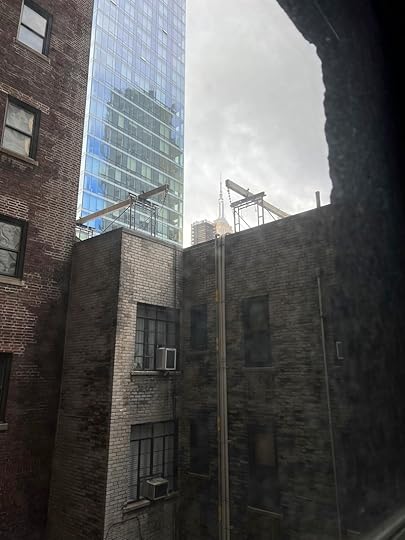
▰ The spellcheck in Slack doesn’t recognize “Akihabara.” Oh, neither does this one. Must be system-wide.
▰ After seeing that new Taylor Swift album art, I kinda expected a Joy Division cover or two
▰ I saw a lot of mysterious doorways in Manhattan. This one was a definite favorite:
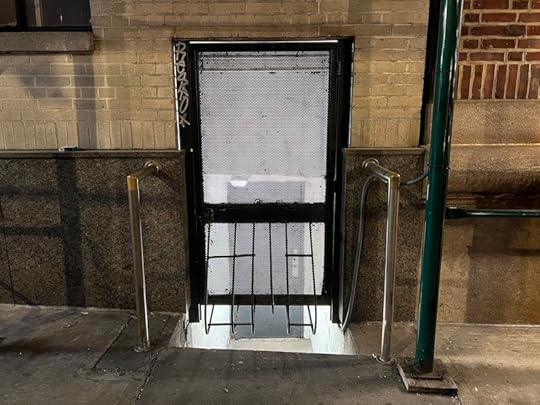
▰ When you get home from a vacation and start receiving the inevitable email offers from restaurants, bookstores, and other places you visited and are now 3,000 miles away from
▰ End of day:
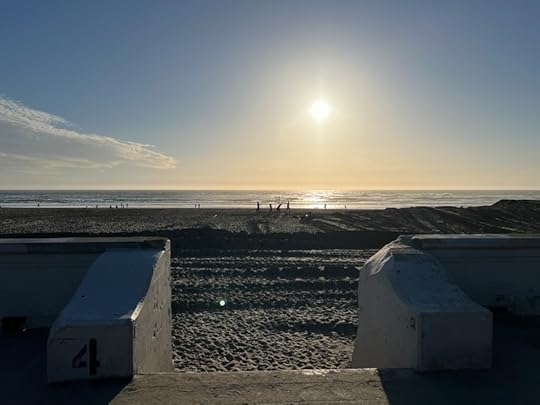
April 19, 2024
Vinyl Surfacing of Siren Recording
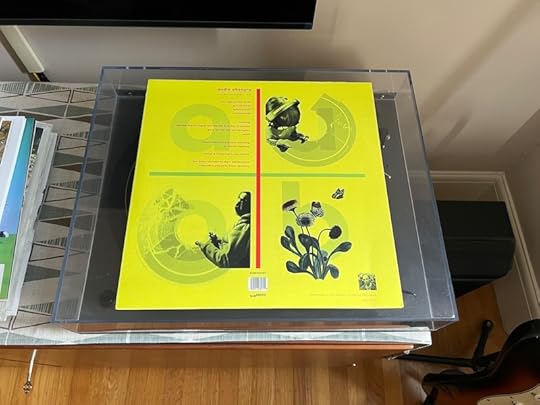
Way back in March 2013, I recorded the Tuesday noon siren that used to resound throughout San Francisco. The siren has since been silenced for municipal budgetary reasons, but the recording lives on. It is one my most listened-to tracks on SoundCloud, and it’s been sampled by various musicians over time — as have other recordings of the siren that circulate on the internet.
And now, for the first time, my recording has appeared on a vinyl record album. Neil Stringfellow, who records as Audio Obscura, opens his new full-length album, Acid Field Recordings in Dub, with a track titled “Through Nuclear Skies,” which begins with my siren recording, before deep dubby sounds take over.
Embedding hasn’t been working for me lately, so head to audioobscura.bandcamp.com to listen. And here’s the original audio:
April 18, 2024
Disquiet Junto Project 0642: Kick from Champagne

Each Thursday in the Disquiet Junto music community, a new compositional challenge is set before the group’s members, who then have five days to record and upload a track in response to the project instructions.
Membership in the Junto is open: just join and participate. (A SoundCloud account is helpful but not required.) There’s no pressure to do every project. The Junto is weekly so that you know it’s there, every Thursday through Monday, when your time and interest align.
Tracks are added to the SoundCloud playlist for the duration of the project. Additional (non-SoundCloud) tracks appear in the lllllll.co discussion thread.
These following instructions went to the group email list (via juntoletter.disquiet.com).
Disquiet Junto Project 0642: Kick from Champagne
The Assignment: Use carbonation to make a beat.
Step 1: Make kick drums from the sound of something carbonated.
Step 2: Make a rhythmic track (think techno, but certainly follow your own muse) using the result of Step 1.
Thanks to the folks in the Echo Chamber Slack whose discussion about techno and kicks informed this week’s project.
Tasks Upon Completion:
Label: Include “disquiet0642” (no spaces/quotes) in the name of your track.
Upload: Post your track to a public account (SoundCloud preferred but by no means required). It’s best to focus on one track, but if you post more than one, clarify which is the “main” rendition.
Share: Post your track and a description/explanation at https://llllllll.co/t/disquiet-junto-project-0642-kick-from-champagne/
Discuss: Listen to and comment on the other tracks.
Additional Details:
Length: The length is up to you.
Deadline: Monday, April 22, 2024, 11:59pm (that is: just before midnight) wherever you are.
About: https://disquiet.com/junto/
Newsletter: https://juntoletter.disquiet.com/
License: It’s preferred (but not required) to set your track as downloadable and allowing for attributed remixing (i.e., an attribution Creative Commons license).
Please Include When Posting Your Track:
More on the 642nd weekly Disquiet Junto project, Kick from Champagne — The Assignment: Use carbonation to make a beat — at https://disquiet.com/0642/
April 17, 2024
More Memory Module Music
Two days ago I posted a preview video I recorded of some virtual synthesizer modules being developed by my friend Mahlen Morris, who does so under the name Stochastic Telegraph. What appears here is a video that Mahlen himself recorded, earlier in the development process, when some of the modules had different names, and at least one of them had fewer features. You can read along in the video as he describes, by typing, what it is that he’s up to in real time. The source audio that he’s working with here is a guitar part that I recorded for him with this delay/buffer approach in mind.
April 16, 2024
… Day … Groundhog Day … Groundhog …
I wrote about one of my favorite movies of all time for hilobrow.com, as part of a series of 25 pieces on “the topic of ‘offbeat’ movies from the Eighties” (the decade loosely defined). Here’s how it opens:
In 1993, the year Groundhog Day hit theaters, that furry near-term Nostradamus named Punxsutawney Phil gazed into the meteorological future and saw his shadow.
Historical records of this Americana hokum date back to the late 1800s, when Groundhog Day first became an annual ritual at Gobbler’s Knob, an inland Pennsylvania town with the sort of Capraesque name that lends itself to fables mixing homespun moralizing, commercial appeal, and a smidgen of self-awareness.
Groundhog Day legend has it that if Phil sees his shadow, winter will last another six weeks. What Phil — and Phil’s handlers, and the makers of the film Groundhog Day — certainly didn’t see coming was that 1993’s elongated winter wouldn’t hold a candle to the staying power of the movie itself.
On the one hand, this may seem off-topic for me — it even did to me, for a moment. I thought about adding a tag to Disquiet.com for “off-topic” things that I may post occasionally, but then I realized that part of the crux of my description of the movie is as follows: “It’s It’s a Wonderful Life reworked for memories trained on instant replay.” Which isn’t just on-topic; it connects directly to what I wrote about just yesterday, about music-making tools that let one access the recent past through memory buffers.
Other pieces in the Hilobrow series include Annie Nocenti on After Hours, Erik Davis on Repo Man, Susannah Breslin on Man Bites Dog, Dean Haspiel on Sid and Nancy, and Carlo Rotella on Robocop. Several are already up, and others will appear in the coming weeks.
April 15, 2024
“Some Time Back”
I was talking, some time back, with a friend of mine about my fascination with buffers in the making of music, with the way digital memory access has become a normal function of sound production. One doesn’t simply play the sound of the moment, with the pluck of a string or the touch of a key on keyboard; one can reach back into the recent past and play something that has already occurred. Furthermore, if we gain a sense of ease in that prior moment, we can linger there, essentially inhabit that pre-moment moment for the length of the performance, and occasionally reach into the future to play that which has, in effect, not yet happened.
My friend, Mahlen Morris, has been developing virtual synthesizer modules for the freely available VCV Rack program. He does so under the splendid name Stochastic Telegraph. He got to thinking about what we were discussing, and began crafting not just one module but a suite of (currently) four modules that can be combined as one sees fit in order to create the memory-access tool of that best suits one’s imagination.
This video is a test run I made of Mahlen’s new tools. The source audio is a sample from a sample set by Lullatone, just a glistening tonal loop that plays on repeat. (It’s the first track off their Bowed Glockenspiel sample set, released back in September 2021.) That loop, 49 seconds long, is housed in that narrow little module to the left of the module labeled Memory. Memory and the five modules to its right are the ones that Mahlen is developing.
In a brief and far from comprehensive summary:
“Memory” contains the audio“Depict” shows the waveform that represents not just the recording but the play heads (left hand horizontal lines) and record heads (right hand horizontal lines)“Ruminate” accesses and plays the audio (there are three modules doing that work here)“Embelish” is the record head.Even though I have checked in with Mahlen during his development work, I am still myself in the early stages of using these, so I am probably describing some of this incorrectly. (And they are capable of far more than I do or describe here.)
In this video, two of the play heads, the red and blue ones, are traveling at twice the speed of the third play head, which is yellow. This creates an octave gap. For the first 30 seconds, that’s all that is happening. The Embellish module (the purple line on the right side) is recording to the buffer continuously from the Lullatone sample, and those three heads (red, blue, yellow) are accessing it in different ways. The lowest pitched of the play heads, the yellow one, is in “bounce” mode, meaning it plays backwards when it reaches the top. The others start again at the start — though to be clear, the buffer here isn’t constant; it’s being written over from the sample, which itself is looping.
At 30 seconds, I click the start button on the trigger sequencer, called “Algorhythm,” and it plays a simple eight-bar beat in which the third and sixth beats are silent. Each triggered moment causes the red bar to briefly play. Previously it was playing continuously; henceforth it will just play for a split second when triggered. Because it’s always accessing the same source sample, just in different places, it ends up producing a little melody where all the pieces are in tune with each other.
At 1:08, having set a melody of sorts into motion, thanks to the rhythmic consistency, I hit the random button on the Algorhythm module, which makes the remainder of the piece more abstract than what came earlier.
That’s it, three stages of the source audio: first the playback heads on their own, then the introduction of those precise little notes, and then the further randomization of the rhythmic appearance of those notes.
The other modules employed are rudimentary. “Clock” sets the pace. “RND” is a random trigger that sets where the little red play back head lands. “Push” sets the sample running (the player loops continuously — or, in the module’s compressed terminology, “cycle”s it continuously). The “Mixer” combines the three stereo channels. The “Audio” sends the sound out my laptop’s speaker. And the “Record” let me record this video.
Mahlen’s modules aren’t available yet, but they will be soon.
April 14, 2024
Haring 1984 Boombox
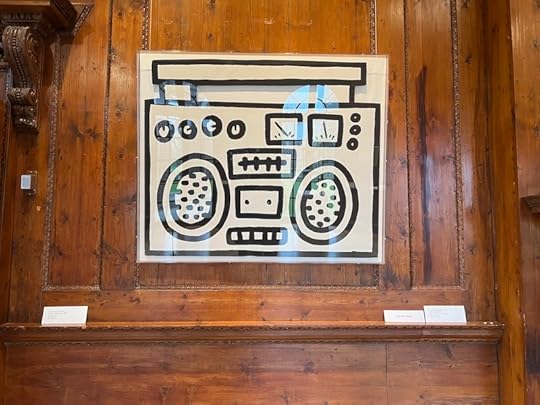
A Keith Haring boombox illustration from 1984, displayed as part of the Urban Art Evolution exhibit at the Nassau County Museum of Art through July 7, 2024



